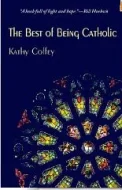Under the sullen grey skies of January, some of us dread the return to ordinary time: the end of colorful lights, festive meals, carols, decorated trees, cookies, gatherings of those we love, the sweetness of the Christmas pageant. This year, some realities seem to hit with more harshness: the violence, greed, lies, cruelty, contempt for law and the environment that characterize this administration. We can resonate with Isaiah’s description of “the people who sit in darkness.” Where’s the light?
A few glimmers: Bishop Budde of the National Cathedral in Washington, D.C. confirmed in her talk on Christmas Eve: we may want another world, but this is it. Imperfect as it is, it may not be what God wanted either. But she reminds us of the lesson from improv. theater—act in the scene you’re in, not the one you want. (That acceptance seems to echo in Jesus’ response to John the Baptist, hardly a conventional character: “Then he allowed him.”)Isaac Slater enlarges the metaphor in his book, Do Not Judge Anyone. In an improvisational skit, the actor “can either block or accept the cues offered by a partner.” The skilled actor “overaccepts,” “takes on the cue with a kind of wild generosity spinning it in some new unforeseen and imaginative direction.” (p. 25) Isn’t that how God acts, with crazy creativity? The message of Christmas: nothing we face lies outside the reach of God’s love. God comes not into all that’s right, but in the midst of what’s broken. And some beautiful transformations ensue.
For example, a difficult situation with the unhoused in San Jose, CA. Neighbors were rightly concerned about fires, break-ins and pollution of the Guadalupe River which flowed through the encampment and their back yards. They fought the first proposal for a housing project, a classic NIMBY stance. But eight years later, Mayor Matt Mahan promised residents that the Cherry Ave. project would improve their neighborhoods and guaranteed that if any problems occurred there, the city would respond immediately. He believes getting people into dignified shelter quickly, instead of waiting years for funding and construction, can make a big difference. Indeed it has: 23% fewer people died on the streets from violence and extreme weather this year. The neighbors are so pleased, they’ve sent welcome baskets with hand-written notes, and volunteered weekends to set up rooms with sheets and laundry supplies. A county supervisor donated to the baskets; a city councilmember helped put them together. As one resident said, “I don’t want to always be the complainer. I want to be part of the solution.” (East Bay Times, 1/5/26, 1,6.)
God’s affirmation of Jesus as “beloved child” comes to each of us, bringing the confidence and support we need to face tough times. It may be easy to nod in agreement with John’s letter: “Children, we belong to God” when our mouths are stuffed with turkey or pie, but what about in the ICU? The traffic? The dentist’s chair? The immigration court?
Even there: another glimmer. District Judge P. Casey Pitts of Northern California has temporarily blocked ICE agents from arresting migrants at immigration courts in his jurisdiction. The presence of ICE has a chilling effect on those who are trying to do the right thing, showing up for their hearings. The horror tales of deportations further undermine the judicial process. The racist myth that these refugees have criminal records has often been disproven, yet they are dehumanized. It’s a far cry from “beloved child,” but let’s applaud the efforts to correct this demeaning treatment.
God is here too, working in and through us, puny as our efforts may seem. We may not see the heavens open or the Spirit descending, but that inner voice reminds, “with you I am well pleased.”

